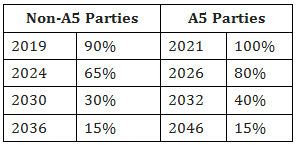By Yan Gu, Summer Intern and Masters in Climate & Society Student
Along with the automobile industry, the aviation industry has recently been more closely concerned with climate change than ever before. On a global scale, however, the soaring number of flights is counteracting the industry’s efforts to increase aircraft energy efficiency. To better understand the elements contributing to aviation’s carbon emissions, the World Bank Development Research Group recently published a working paper examining the carbon footprint of airline travel.
Titled “Calculating the Carbon Footprint from Different Classes of Air Travel,” the report analyzes the carbon footprint of first and business classes via a new measurement methodology. By applying the class-based methodology to the traveling data of World Bank Group (WBG) staff in 2009 and 2012, the working group scientists have found how surprisingly high the greenhouse gas (GHG) footprint of flying in a more expensive class can be–nine times higher than an economy-class seat. The main reason, according to their findings, is that fuel consumption depends more on space than weight. A premium-class passenger displaces a number of economy-class passengers by taking up their space at the cost of leaving a huge carbon footprint.
Measuring the GHG footprint of air travel confronts two uncertainties, which the report attempts to overcome. First, due to the unique location of aviation’s GHG emissions—into the upper troposphere and lower stratosphere—their total warming effect is not easy to determine. Second, the actual average GHG emissions per unit traveled is a matter of a number of factors which are all subject to change. Previous methodologies are either ambiguous or controversial. That made the class-based approach radical, “in the sense that it in some respects extends well beyond currently accepted standards for measuring carbon footprints of air travel, by making them more precise.”
The new methodology of measuring carbon footprint has important implications for corporate responsibility. Although staff air travel is not required to be reported under the GHG protocol, the World Bank still expressed concern with including it in efforts to offset its own carbon footprint, noting that “any attempt to offset emissions would be of limited consequence without consideration of this (air travel) emissions category.” Among all of the WBG staff air travel, 70-80% takes place in premium classes. And although first-class travel decreased by 13 percent between 2009 and 2012, air travel still constitutes over 50% of the institution’s carbon footprint, the largest part by far. The World Bank Group has set a goal to be a carbon neutral organization and has set up an Inventory Management Plan to track its emission worldwide. Accurately measuring this large component of its carbon footprint is important for correct offsetting actions.
The paper also discusses broader implications it might have beyond contributing to the WBG’s internal climate policies. For example, the EU requirement that all airlines flying within EU obtain allowances to cover their assessed CO2 emissions. (It should be noted, however, that the EU’s regulation of flights that enter or leave the EU met with significant international opposition, and has been temporarily suspended.) The World Bank report suggests that first-class passengers should be charged differently from economy class on EU airlines to reflect and cover the different amounts of emission.
The World Bank’s report might also have interesting implications for future anticipated international regulation of aviation. The UN’s International Civil Aviation Organization (ICAO) is currently working on designing market-based measures (MBMs) to respond to carbon emissions within the international aviation industry, with a proposal expected to emerge from ICAO’s High-Level Meeting on International Aviation and Climate Change to be held in September 2013. The World Bank’s report shows “how carbon surcharges on different classes of travel would differ if carbon emissions from international aviation were taxed”. It will be interesting to see how the World Bank’s findings might play into the design of ICAO MBMs and airlines’ implementation methods for the MBMs.
Similarly, the International Air Transport Association (IATA), which works closely with ICAO, has in place a set of best practice guidelines for airline offsets and has launched an Industry Carbon Offset Program uniting airlines, manufacturing, and infrastructure providers. Over 30 IATA member airlines provide their own program for their passengers to voluntarily reduce their carbon footprint. Of course, airline class is only one of the factors that should be taken into account when calculating aviation’s carbon footprint. But the World Bank report’s findings of the huge difference between classes might lead to refinement of ICAO’s and IATA’s methodologies, influence the design of new offsetting programs, and, hopefully, have an impact on the traveling choices of institutions and corporations committed to sustainability.



